Microwave Absorption Properties of Multi-Walled Carbon Nanotubes/Carbonyl Iron Particles/Polyurethane Foams
Abstract
:1. Introduction
2. Sample Preparation
2.1. Material Preparation
2.2. Material Characterization and Measurement
3. Electromagnetic Performance
3.1. Electromagnetic Parameters
3.2. Microwave Absorption Performance
4. Simulation of Interference Suppression Effect of Microwave Absorbing Materials
4.1. High-Power Microwave (HPM)
4.2. Ultra-Wideband Pulse (UWB)
4.3. High Altitude Nuclear Electromagnetic Pulse (NEMP)
5. Experimental Study on Anti-Electromagnetic Radiation for Absorbing Material
5.1. Test System
5.2. Experimental Subject
5.3. Strong Electromagnetic Field Irradiation Test
- (1)
- Generate a strong electromagnetic field environment with the transmitting antenna, select the location of the product to be measured, and then use the field strength meter to measure whether the electric field strength of the location under different frequency points meets the requirements (according to 200 V/m, 500 V/m, 800 V/m, gradually increasing the field strength).
- (2)
- The product with the actuation circuit is placed in the optimal energy coupling direction, then start irradiation, with a dwell time of 2 s at each frequency point. Observe the buzzer to see if it beeps.
- (3)
- After each frequency point is irradiated, the actuation circuit is checked for continued proper operation.
6. Conclusions
Author Contributions
Funding
Institutional Review Board Statement
Informed Consent Statement
Data Availability Statement
Conflicts of Interest
References
- Kong, L.B.; Li, Z.W.; Liu, L.; Huang, R.; Abshinova, M.; Yang, Z.H.; Tang, C.B.; Tan, P.K.; Deng, C.R.; Matitsine, S. Recent progress in some composite materials and structures for specific electromagnetic applications. Int. Mater. Rev. 2013, 58, 203–259. [Google Scholar] [CrossRef]
- Li, X.H.; Yi, H.B.; Zhang, J.W.; Feng, J.; Li, F.S.; Xue, D.S.; Zhang, H.L.; Peng, Y.; Mellors, N.J. Fe3O4-graphene hybrids: Nanoscale characterization and their enhanced electromagnetic wave absorption in gigahertz range. J. Nanopart. Res. 2013, 15, 11. [Google Scholar] [CrossRef]
- Qing, Y.C.; Zhou, W.C.; Luo, F.; Zhu, D.M. Epoxy-silicone filled with multi-walled carbon nanotubes and carbonyl iron particles as a microwave absorber. Carbon 2010, 48, 4074–4080. [Google Scholar] [CrossRef]
- Tan, Y.J.; Li, J.; Tang, X.H.; Yue, T.N.; Wang, M. Effect of phase morphology and distribution of multi-walled carbon nanotubes on microwave shielding of poly(L-lactide)/poly(epsilon-caprolactone) composites. Compos. Part A—Appl. Sci. Manuf. 2020, 137, 10. [Google Scholar] [CrossRef]
- Tang, X.H.; Li, J.; Wang, Y.; Weng, Y.X.; Wang, M. Controlling distribution of multi-walled carbon nanotube on surface area of Poly(epsilon-caprolactone) to form sandwiched structure for high-efficiency electromagnetic interference shielding. Compos. Part B—Eng. 2020, 196, 9. [Google Scholar] [CrossRef]
- Wang, T.; Yu, W.C.; Sun, W.J.; Jia, L.C.; Gao, J.F.; Tang, J.H.; Su, H.J.; Yan, D.X.; Li, Z.M. Healable polyurethane/carbon nanotube composite with segregated structure for efficient electromagnetic interference shielding. Compos. Sci. Technol. 2020, 200, 9. [Google Scholar] [CrossRef]
- Jing, W.; Chen, W.C.; Liu, Y.; Deng, J.J. A Review of Carbon-based Microwave Absorbing Composites. In Proceedings of the Conference on Advanced Laser Materials and Laser Technology (AOPC), Beijing, China, 7–9 July 2019. [Google Scholar]
- Dalal, J.; Lather, S.; Gupta, A.; Dahiya, S.; Maan, A.S.; Singh, K.; Dhawan, S.K.; Ohlan, A. EMI shielding properties of laminated graphene and PbTiO3 reinforced poly (3,4-ethylenedioxythiophene) nanocomposites. Compos. Sci. Technol. 2018, 165, 222–230. [Google Scholar] [CrossRef]
- Dalal, J.; Malik, S.; Dahiya, S.; Punia, R.; Singh, K.; Maan, A.S.; Dhawan, S.K.; Ohlan, A. One pot synthesis and electromagnetic interference shielding behavior of reduced graphene oxide nanocomposites decorated with Ni0.5Co0.5Fe2O4 nanoparticles. J. Alloys Compd. 2021, 887, 11. [Google Scholar] [CrossRef]
- Luo, H.; Gong, R.Z.; Wang, X.; Song, K.; Zhu, C.M.; Wang, L.G. Synthesis and excellent microwave absorption properties of reduced graphene oxide/FeNi3/Fe3O4 composite. New J. Chem. 2016, 40, 6238–6243. [Google Scholar] [CrossRef]
- Xie, D.; Wei, H.Y.; He, M.; An, R.; Liang, J.H.; Liu, N.; Zhang, Z.P. Ferromagnetic/carbon material complexes for wave absorbing materials. Mater Rev. 2017, 31, 125–128. [Google Scholar]
- Luo, J. Preparation and Study of Metal Oxide/Graphene Composite Wave Absorbing Materials. Master’s Thesis, Beijing University of Chemical Technology, Beijing, China, 2015. [Google Scholar]
- Zhang, S.L. Preparation and Performance Study of Carbon Nanotube (Graphene)/Ferrite Composites. Ph.D. Thesis, Beijing Institute of Technology, Beijing, China, 2016. [Google Scholar]
- Sun, X.; Xing, H.L.; Liu, Z.F.; Wang, L.; Shen, Z.Y. Preparation of CoFe2O4/MWCNTs composites by co-precipitation method and microwave absorption properties. Anhui Chem. Ind. 2017, 43, 19–22. [Google Scholar]
- Feng, A.L.; Jia, Z.R.; Zhao, Y.; Lv, H.L. Development of Fe/Fe3O4@C composite with excellent electromagnetic absorption performance. J. Alloys Compd. 2018, 745, 547–554. [Google Scholar] [CrossRef]
- Tang, Y.T.; Yin, P.F.; Zhang, L.M.; Wang, J.; Feng, X.; Wang, K.M.; Dai, J.W. Novel carbon encapsulated zinc ferrite/MWCNTs composite: Preparation and low-frequency microwave absorption investigation. Ceram. Int. 2021, 47, 7291. [Google Scholar] [CrossRef]
- Kazakova, M.A.; Semikolenova, N.V.; Korovin, E.Y.; Zhuravlev, V.A.; Selyutin, A.G.; Velikanov, D.A.; Moseenkov, S.I.; Andreev, A.S.; Lapina, O.B.; Suslyaev, V.I.; et al. Co/multi-walled carbon nanotubes/polyethylene composites for microwave absorption: Tuning the effectiveness of electromagnetic shielding by varying the components ratio. Compos. Sci. Technol. 2021, 207, 11. [Google Scholar] [CrossRef]
- Singh, N.; Aul, G.D. Fabrication of cobalt filled multi-walled carbon nanotubes/polyurethane composite for microwave absorption. SN Appl. Sci. 2020, 2, 2026. [Google Scholar] [CrossRef]
- Wu, Y.; Shu, R.W.; Zhang, J.B.; Wan, Z.L.; Shi, J.J.; Liu, Y.; Zhao, G.M.; Zheng, M.D. Oxygen vacancies regulated microwave absorption properties of reduced graphene oxide/multi-walled carbon nanotubes/cerium oxide ternary nanocomposite. J. Alloys Compd. 2020, 819, 11. [Google Scholar] [CrossRef]
- Chen, H.H.; Huang, Z.Y.; Huang, Y.; Zhang, Y.; Ge, Z.; Qin, B.; Liu, Z.F.; Shi, Q.; Xiao, P.S.; Yang, Y.; et al. Synergistically assembled MWCNT/graphene foam with highly efficient microwave absorption in both C and X bands. Carbon 2017, 124, 506–514. [Google Scholar] [CrossRef]
- Khani, O.; Shoushtaria, M.Z.; Ackland, K.; Stamenov, P. The structural, magnetic and microwave properties of spherical and flake shaped carbonyl iron particles as thin multilayer microwave absorbers. J. Magn. Mater. 2017, 428, 28–35. [Google Scholar] [CrossRef]
- Jing, H.X.; Li, Q.L.; Ye, Y.; Pei, W.J. Preparation and wave absorption properties of carbonyl iron/barium titanate composites. J. Mater. Eng. 2015, 43, 38–42. [Google Scholar]
- Xu, Y.G.; Zhang, D.Y.; Cai, J.; Yuan, L.M.; Zhang, W.Q. Effects of Multi-walled Carbon Nanotubes on the Electromagnetic Absorbing Characteristics of Composites Filled with Carbonyl Iron Particles. J. Mater. Sci. Technol. 2012, 28, 34–40. [Google Scholar] [CrossRef]
- Qing, Y.C.; Zhou, W.C.; Jia, S.; Luo, F.; Zhu, D.M. Electromagnetic and microwave absorption properties of carbonyl iron and carbon fiber filled epoxy/silicone resin coatings. Appl. Phys. A—Mater. Sci. Process. 2010, 100, 1177–1181. [Google Scholar] [CrossRef]
- Kausar, A. Polyurethane Composite Foams in High-Performance Applications: A Review. Polym.-Plast. Technol. Eng. 2018, 57, 346–369. [Google Scholar] [CrossRef]
- Wang, X.X.; Ma, T.; Shu, J.C.; Cao, M.S. Confinedly tailoring Fe3O4 clusters-NG to tune electromagnetic parameters and microwave absorption with broadened bandwidth. Chem. Eng. J. 2018, 332, 321–330. [Google Scholar] [CrossRef]
- Calame, J.P. Evolution of Davidson-Cole relaxation behavior in random conductor-insulator composites. J. Appl. Phys. 2003, 94, 5945–5957. [Google Scholar] [CrossRef]
- Qing, Y.C.; Min, D.D.; Zhou, Y.Y.; Luo, F.; Zhou, W.C. Graphene nanosheet- and flake carbonyl iron particle-filled epoxy-silicone composites as thin-thickness and wide-bandwidth microwave absorber. Carbon 2015, 86, 98–107. [Google Scholar] [CrossRef]
- Qing, Y.C.; Wang, X.; Zhou, Y.Y.; Huang, Z.B.; Luo, F.; Zhou, W.C. Enhanced microwave absorption of multi-walled carbon nanotubes/epoxy composites incorporated with ceramic particles. Compos. Sci. Technol. 2014, 102, 161–168. [Google Scholar] [CrossRef]
- Luo, J.H.; Xu, Y.; Yao, W.; Jiang, C.F.; Xu, J.G. Synthesis and microwave absorption properties of reduced graphene oxide-magnetic porous nanospheres-polyaniline composites. Compos. Sci. Technol. 2015, 117, 315–321. [Google Scholar] [CrossRef]
- Gonzalez, M.; Baselga, J.; Pozuelo, J. High porosity scaffold composites of graphene and carbon nanotubes as microwave absorbing materials. J. Mater. Chem. C 2016, 4, 8575–8582. [Google Scholar] [CrossRef]
- Korneva, G.; Ye, H.H.; Gogotsi, Y.; Halverson, D.; Friedman, G.; Bradley, J.C.; Kornev, K.G. Carbon nanotubes loaded with magnetic particles. Nano Lett. 2005, 5, 879–884. [Google Scholar] [CrossRef]
- Wen, F.; Yi, H.; Qiao, L.; Zheng, H.; Zhou, D.; Li, F. Analyses on double resonance behavior in microwave magnetic permeability of multiwalled carbon nanotube composites containing Ni catalyst. Appl. Phys. Lett. 2008, 92, 3. [Google Scholar] [CrossRef]
- Zhang, X.F.; Dong, X.L.; Huang, H.; Liu, Y.Y.; Wang, W.N.; Zhu, X.G.; Lv, B.; Lei, J.P.; Lee, C.G. Microwave absorption properties of the carbon-coated nickel nanocapsules. Appl. Phys. Lett. 2006, 89, 3. [Google Scholar] [CrossRef]
- Fang, Z.G.; Cao, X.M.; Li, C.S.; Zhang, H.T.; Zhang, J.S.; Zhang, H.Y. Investigation of carbon foams as microwave absorber: Numerical prediction and experimental validation. Carbon 2006, 44, 3368–3370. [Google Scholar] [CrossRef]
- Zhang, M.W.; Qu, G.D.; Pang, M.Y.; Liu, R.; Cao, G.Y.; Li, Z. Research progress of electromagnetic shielding mechanism and coated/structured wave absorbing composites. Mater Rev. 2021, 35, 62–70. [Google Scholar]
- Lv, H.L.; Liang, X.H.; Ji, G.B.; Zhang, H.Q.; Du, Y.W. Porous Three-Dimensional Flower-like Co/CoO and Its Excellent Electromagnetic Absorption Properties. ACS Appl. Mater. Interfaces 2015, 7, 9776–9783. [Google Scholar] [CrossRef] [PubMed]
- Zhao, B.; Shao, G.; Fan, B.B.; Zhao, W.Y.; Zhang, R. Investigation of the electromagnetic absorption properties of Ni@TiO2 and Ni@SiO2 composite microspheres with core-shell structure. Phys. Chem. Chem. Phys. 2015, 17, 2531–2539. [Google Scholar] [CrossRef] [PubMed]
- Yan, F.; Zhang, S.; Zhang, X.; Li, C.Y.; Zhu, C.L.; Zhang, X.T.; Chen, Y.J. Growth of CoFe2O4 hollow nanoparticles on graphene sheets for high-performance electromagnetic wave absorbers. J. Mater. Chem. C 2018, 6, 12781–12787. [Google Scholar] [CrossRef]
- Thomas, D.W.P.; Denton, A.C.; Konefal, T.; Benson, T.; Christopoulos, C.; Dawson, J.F.; Marvin, A.; Porter, S.J.; Sewell, P. Model of the electromagnetic fields inside a cuboidal enclosure populated with conducting planes or printed circuit boards. IEEE Trans. Electromagn. Compat. 2001, 43, 161–169. [Google Scholar] [CrossRef]
- Li, Y.L.; Yan, X.P.; Hao, X.H.; Yue, K.; Jin, X. Study of the coupling effect of ultra-broadband electromagnetic pulse on typical fuses. High Power Laser Part. Beams 2014, 26, 229–233. [Google Scholar]
- Chen, K.J.; Gao, M.; Zhou, X.D.; Hui, J.H. FM continuous wave fuze high power microwave front door coupling effect study. Acta Armamentarii 2020, 41, 881–889. [Google Scholar]
- Hu, R. Research on the Mechanism of Strong Electromagnetic Pulse Coupling in Satellite Navigation Receivers. Master’s Thesis, Beijing Jiaotong University, Beijing, China, 2018. [Google Scholar]
- Wei, G.H.; Li, K.; Pan, X.D.; Zhang, L.; Li, X.F. Simulation of the formation mechanism of electromagnetic field enhancement effect in metal cavities containing pores and seams. High Volt. Technol. 2014, 40, 1637–1643. [Google Scholar]
- Xiao, J.S.; Liu, W.H.; Zhang, S.Y.; Zhang, J.H. Numerical simulation of the coupling effect of ultra-broadband electromagnetic pulse on cavity pore slit. High Power Laser Part. Beams 2010, 22, 2959–2963. [Google Scholar] [CrossRef]
- Ding, Y. Study of Nuclear Electromagnetic Pulse Cable Coupling Effect. Master’s Thesis, Beijing Jiaotong University, Beijing, China, 2009. [Google Scholar]
- Wang, T.R. Electromechanical Fuze Anti-Electromagnetic Interference Analysis and Experimental Research. Master’s Thesis, Nanjing University of Science and Technology, Nanjing, China, 2018. [Google Scholar]
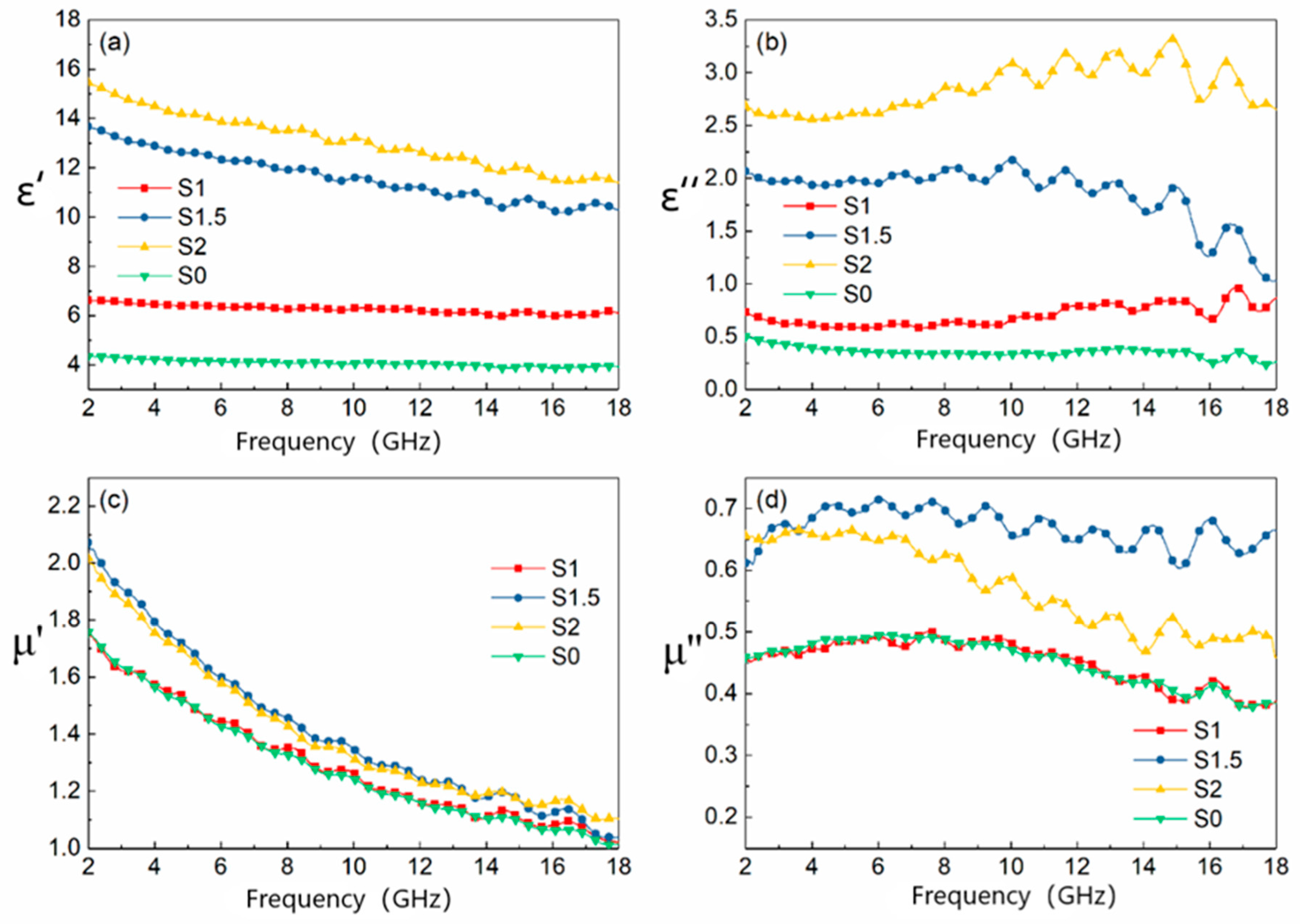

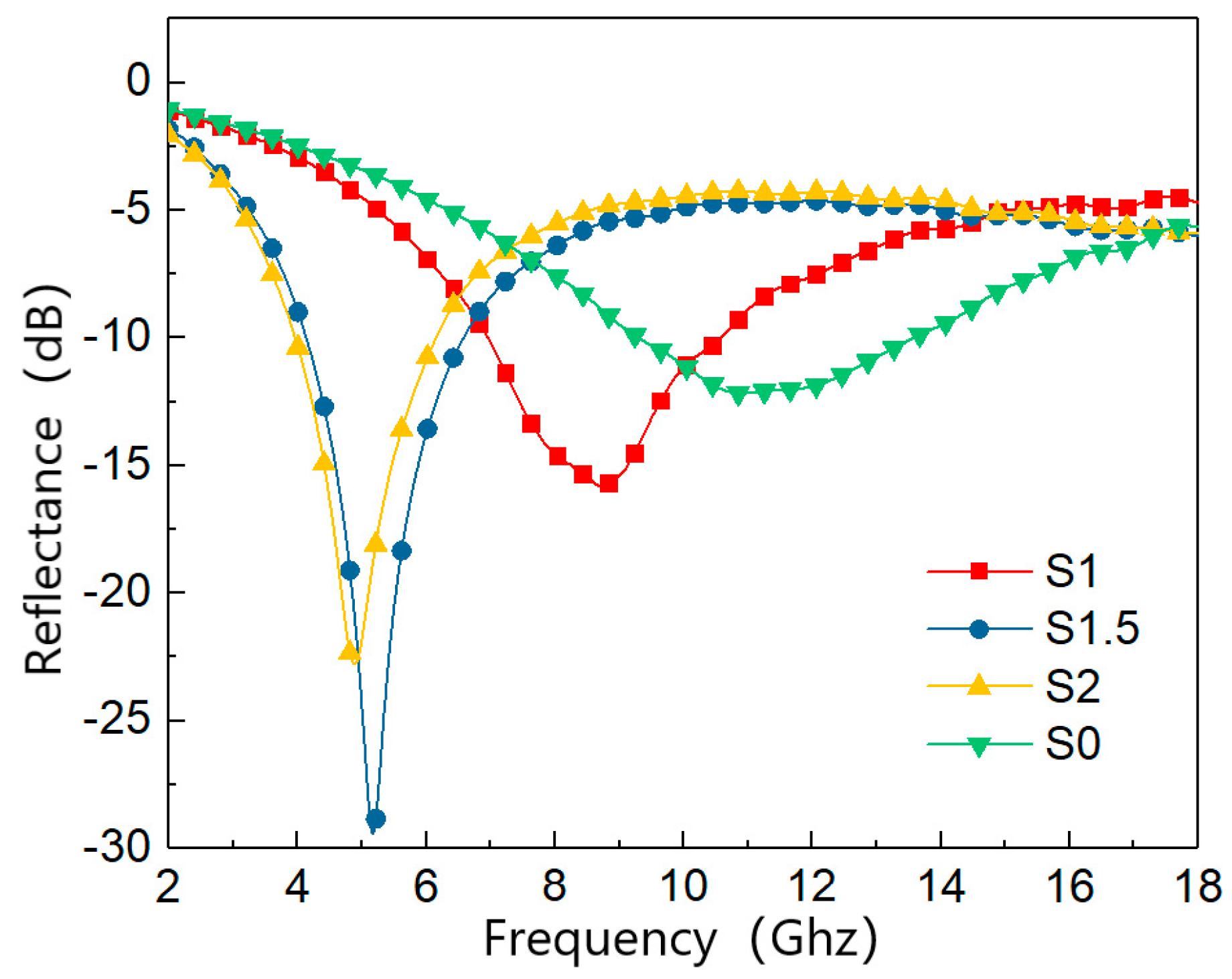
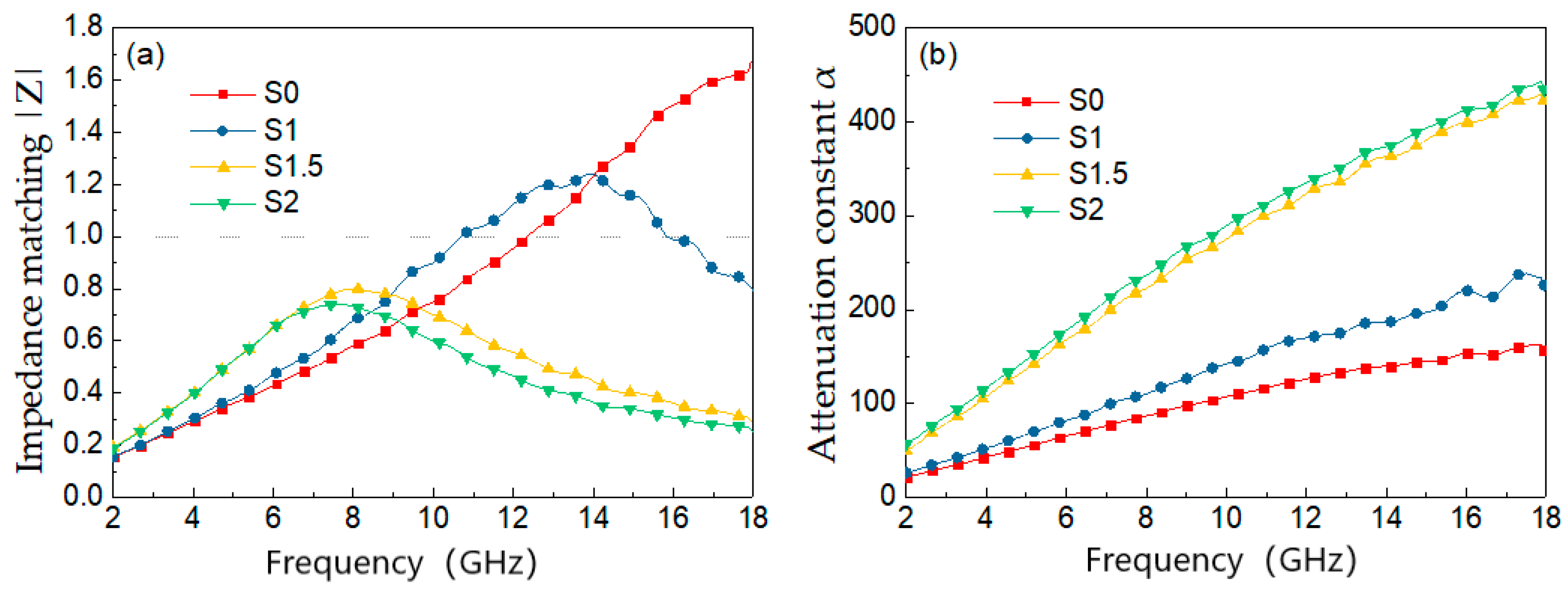
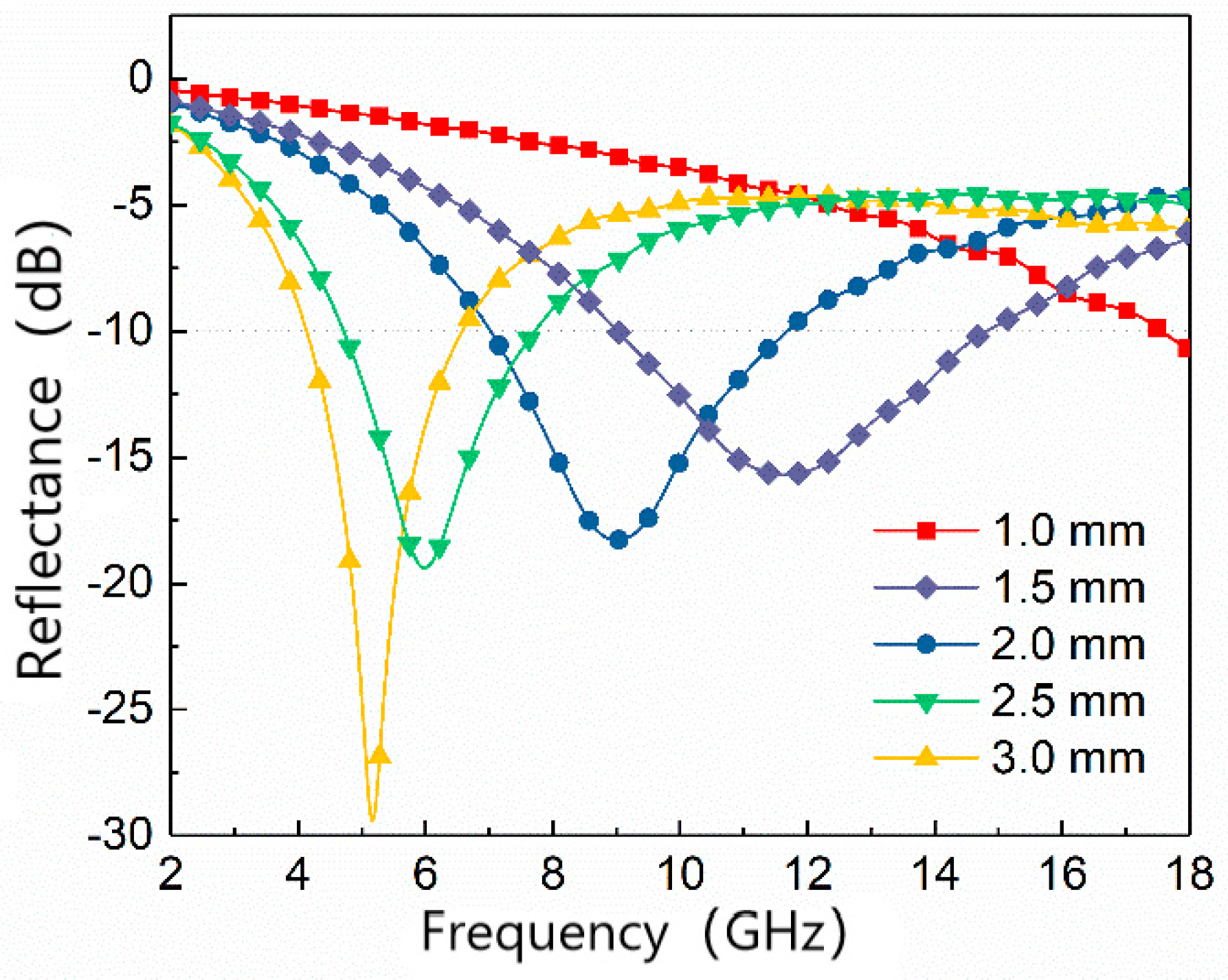

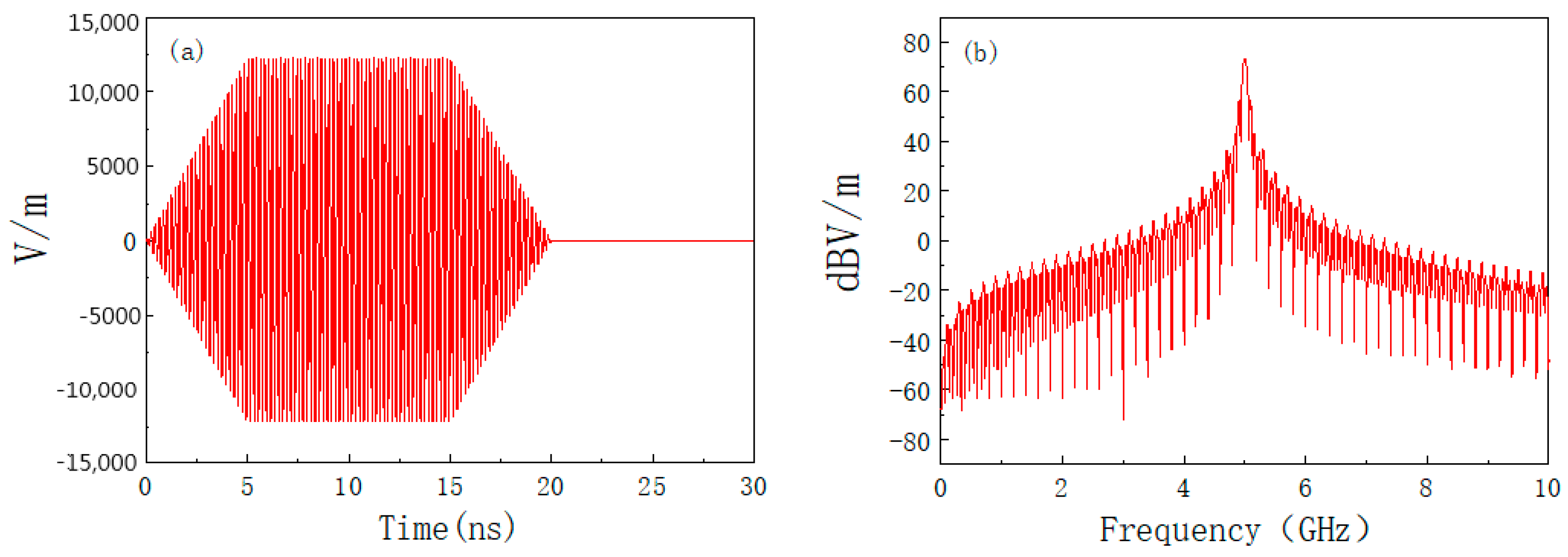

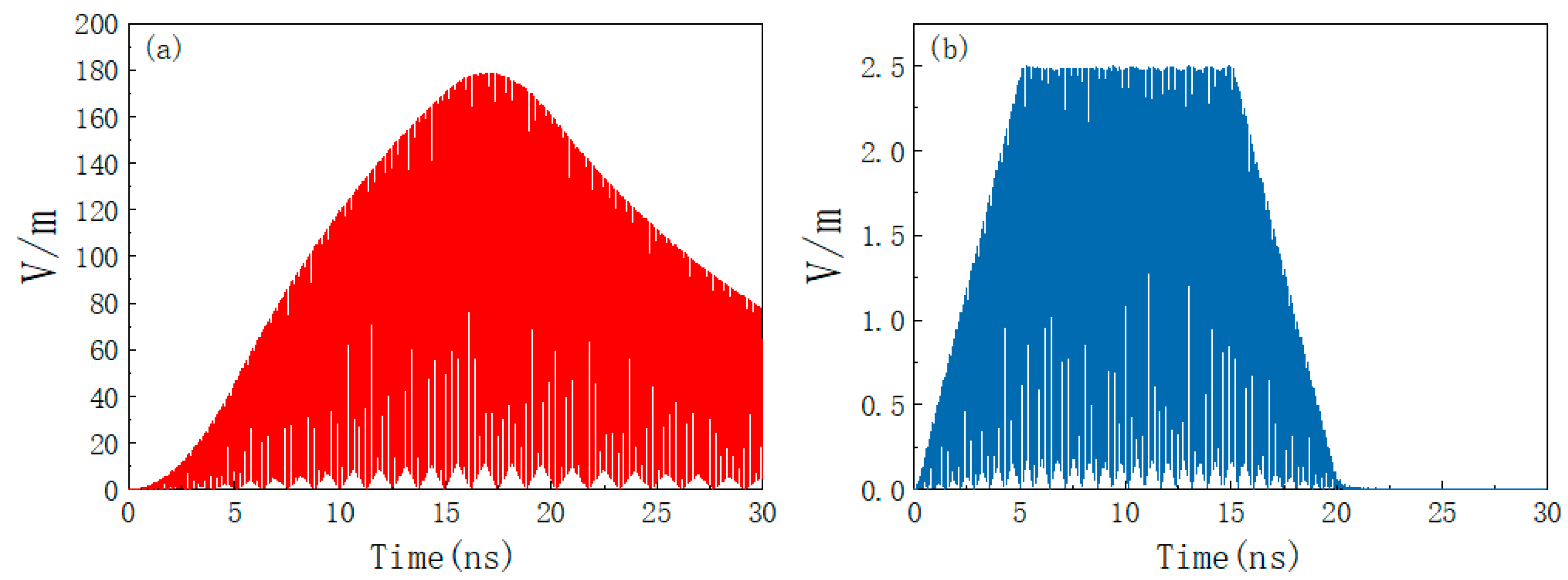

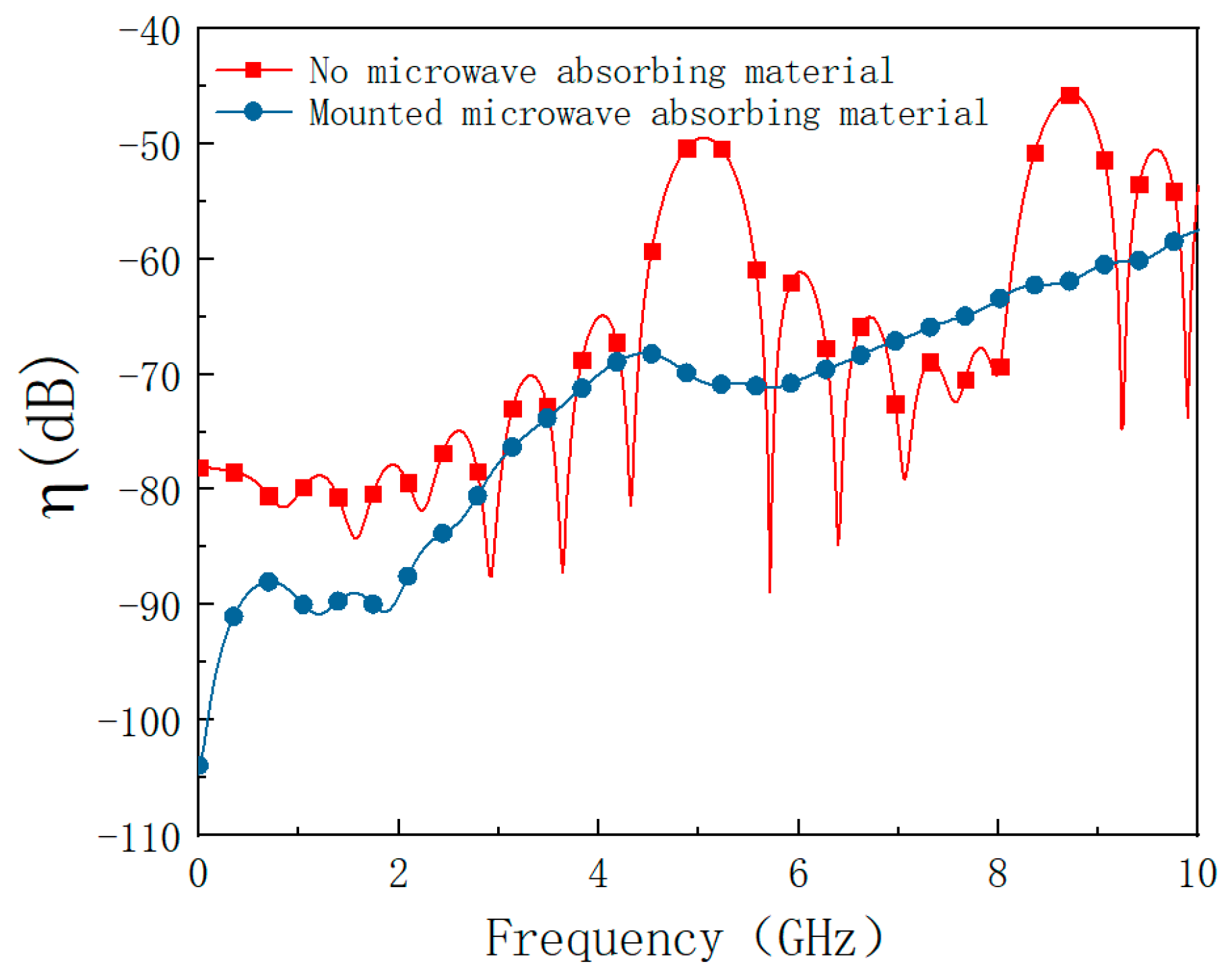
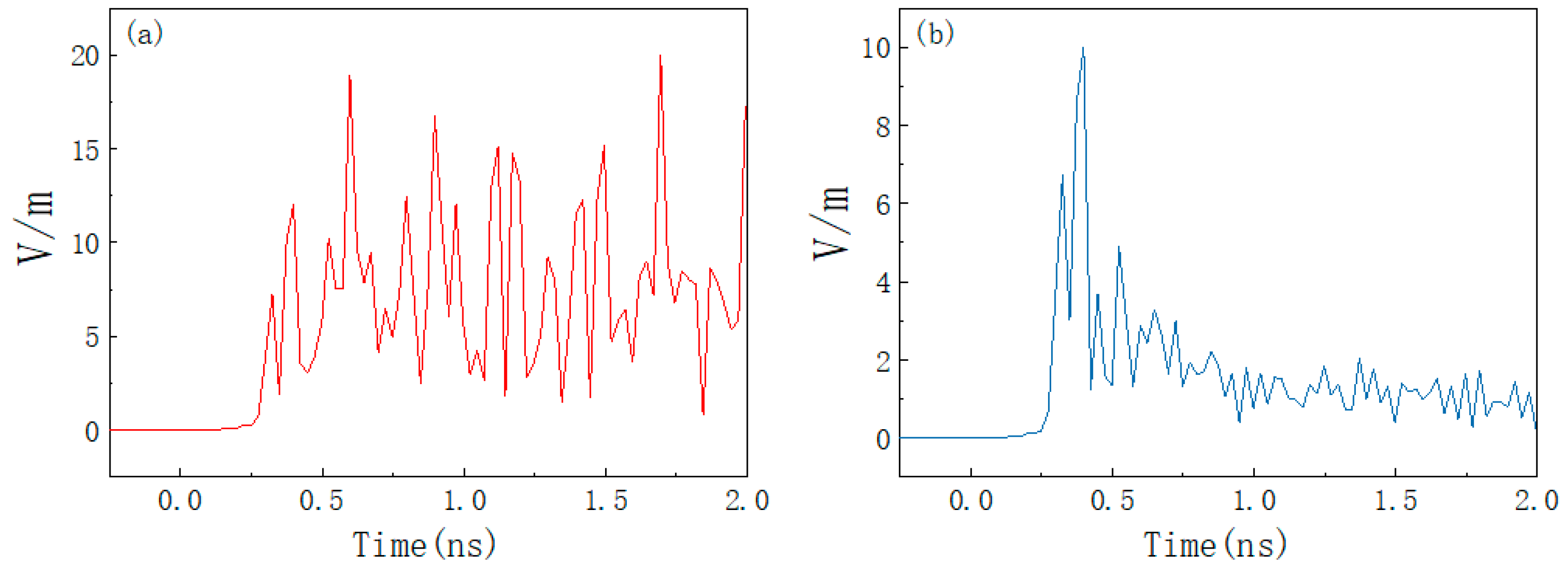

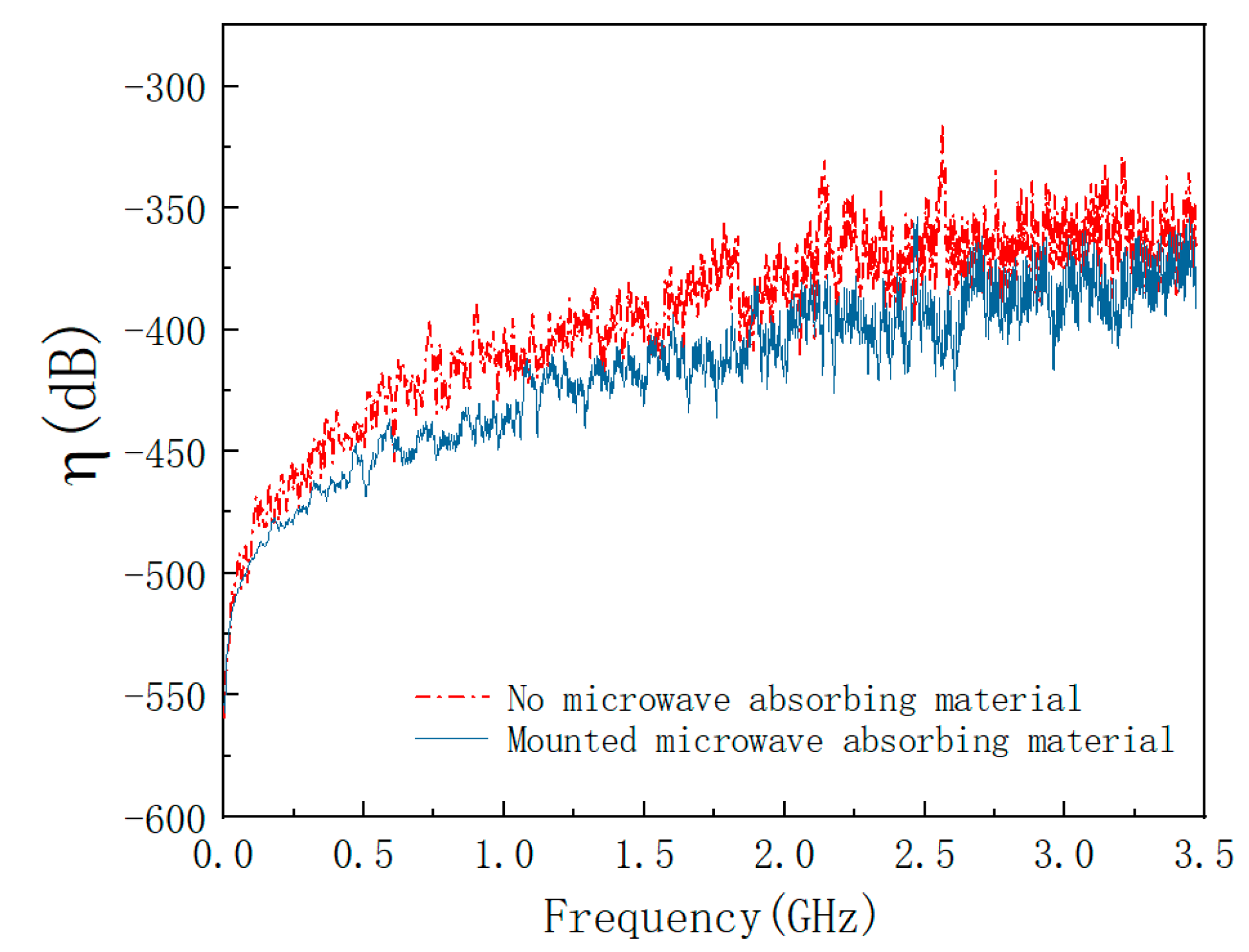
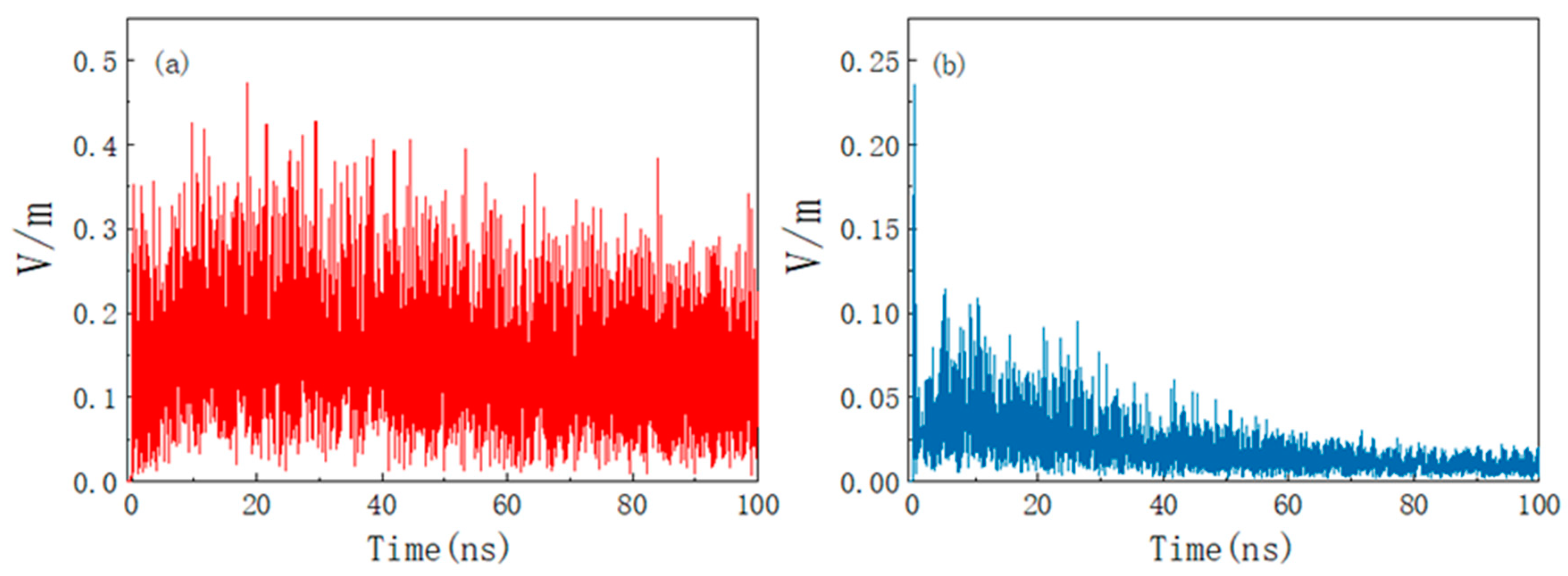
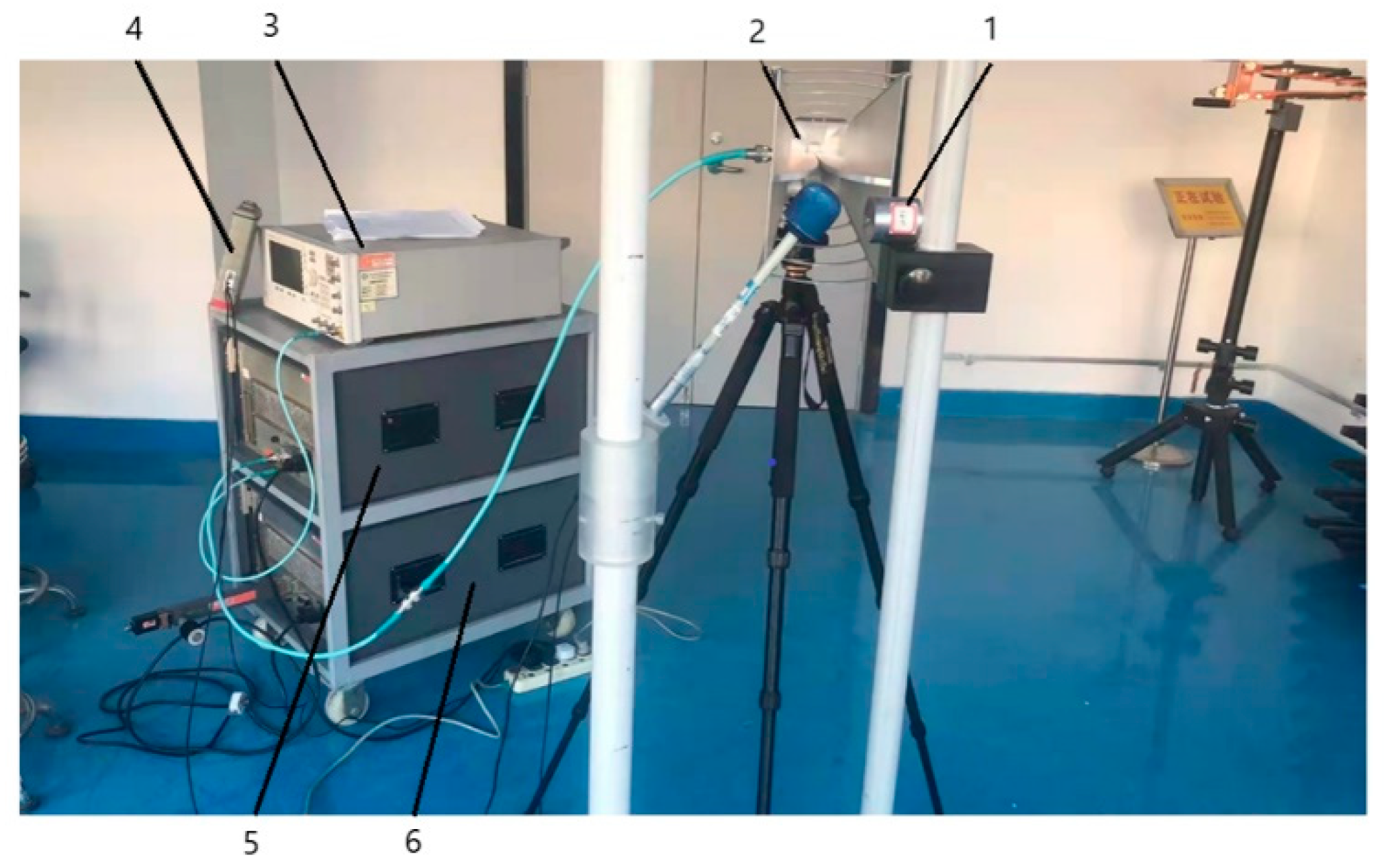
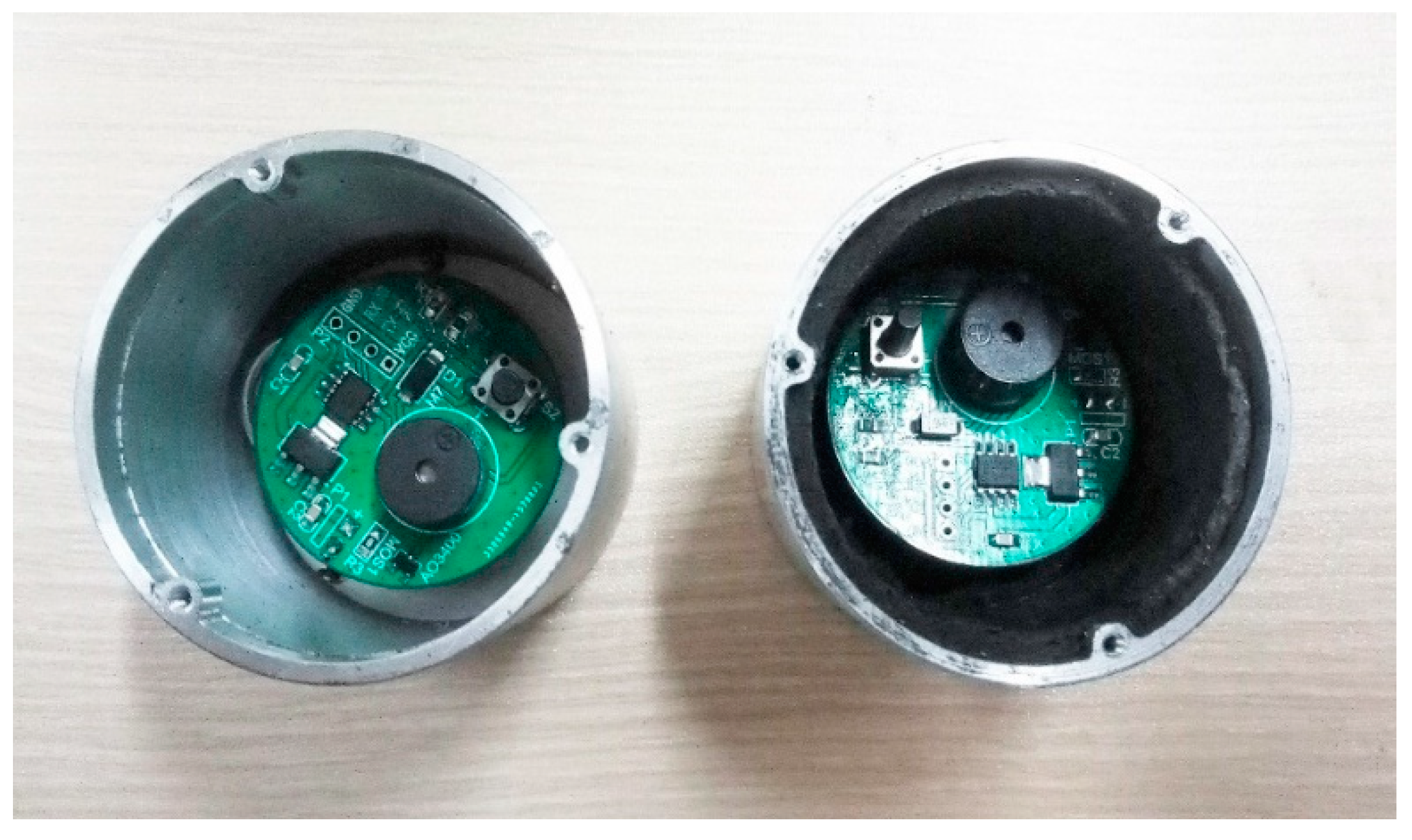
| Year of Publication | Absorber | Technique | Minimum RL (Frequency, Thickness) | Reference |
|---|---|---|---|---|
| 2017 | CoFe2O4/MWCNTs | co-precipitation method | −32.5 dB (8.88 GHz, 2 mm) | [14] |
| 2021 | Co/MWCNTs/polyethylene | situ polymerization of ethylene | −55 dB (5.2 GHz, 4 mm) | [17] |
| 2020 | CobaltSulphate/MWCNTs | three-step method | −30.22 dB (11.8 GHz, 3 mm) | [18] |
| 2020 | RGO/MWCNTs/CeO2 | one-pot hydrothermal route | −59.3 dB (4.6 GHz, 4.5 mm) | [19] |
| 2017 | MWCNT/graphene foam | solvothermal method | −39.5 dB (11.6 GHz, 10.0 mm) | [20] |
| Reagent Name | Manufacturer |
|---|---|
| multi-walled carbon nanotubes | Suiheng Technology Co., Ltd., Shenzhen, China |
| flake carbonyl iron particles | Blue Magnetic New Material Technology Co. Ltd., Guangzhou, China |
| polyether polyol | Hagibis Co., Ltd., Beijing, China |
| polyisocyanate | Hagibis Co., Ltd., Beijing, China |
| resin dispersant | XFNANO Materials Tech Co., Ltd., Nanjing, China |
| Sample No. | MWCNTs (wt.%) | FCI (wt.%) | Polyol (wt.%) | Isocyanate (wt.%) | Dispersant (wt.%) |
|---|---|---|---|---|---|
| S0 | 0 | 70 | 21.4 | 8.6 | 0 |
| S1 | 1 | 70 | 17.8 | 7.2 | 4 |
| S1.5 | 1.5 | 70 | 16 | 6.5 | 6 |
| S2 | 2 | 70 | 14.3 | 5.7 | 8 |
| Frequency (GHz) | Test Result | Frequency (GHz) | Test Result | Frequency (GHz) | Test Result |
|---|---|---|---|---|---|
| 0.1 | - | 3.7 | - | 6.0 | - |
| 0.3 | - | 3.9 | - | 6.1 | - |
| 0.5 | - | 4.1 | - | 6.2 | - |
| 0.7 | - | 4.3 | Beep | 6.3 | - |
| 0.9 | - | 4.5 | - | 6.4 | - |
| 1.1 | - | 4.6 | - | 6.7 | - |
| 1.3 | - | 4.7 | - | 7.0 | - |
| 1.5 | - | 4.8 | Beep | 7.3 | - |
| 1.7 | - | 4.9 | * | 7.6 | - |
| 1.9 | - | 5.0 | * | 7.9 | - |
| 2.1 | - | 5.1 | Beep | 8.2 | - |
| 2.3 | - | 5.2 | - | 8.5 | * |
| 2.5 | - | 5.3 | - | 8.8 | - |
| 2.7 | - | 5.4 | - | 9.1 | - |
| 2.9 | - | 5.5 | - | 9.4 | - |
| 3.1 | - | 5.6 | - | 9.7 | - |
| 3.3 | - | 5.7 | - | 10 | - |
| 3.5 | - | 5.8 | - |
Publisher’s Note: MDPI stays neutral with regard to jurisdictional claims in published maps and institutional affiliations. |
© 2022 by the authors. Licensee MDPI, Basel, Switzerland. This article is an open access article distributed under the terms and conditions of the Creative Commons Attribution (CC BY) license (https://creativecommons.org/licenses/by/4.0/).
Share and Cite
Huang, X.; Yu, D.; Wang, S. Microwave Absorption Properties of Multi-Walled Carbon Nanotubes/Carbonyl Iron Particles/Polyurethane Foams. Materials 2022, 15, 5690. https://doi.org/10.3390/ma15165690
Huang X, Yu D, Wang S. Microwave Absorption Properties of Multi-Walled Carbon Nanotubes/Carbonyl Iron Particles/Polyurethane Foams. Materials. 2022; 15(16):5690. https://doi.org/10.3390/ma15165690
Chicago/Turabian StyleHuang, Xuegong, Danping Yu, and Simin Wang. 2022. "Microwave Absorption Properties of Multi-Walled Carbon Nanotubes/Carbonyl Iron Particles/Polyurethane Foams" Materials 15, no. 16: 5690. https://doi.org/10.3390/ma15165690






